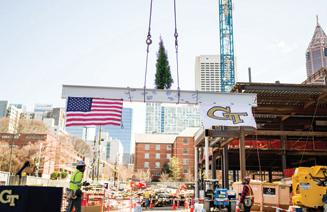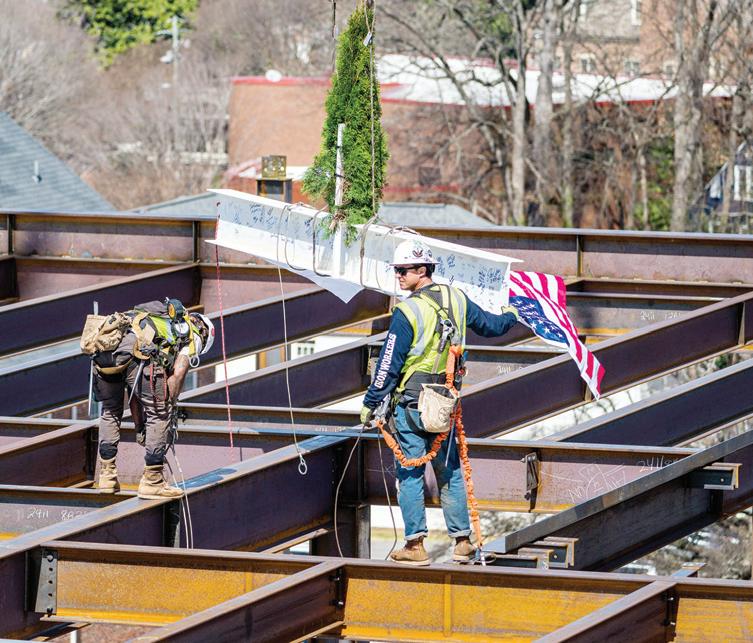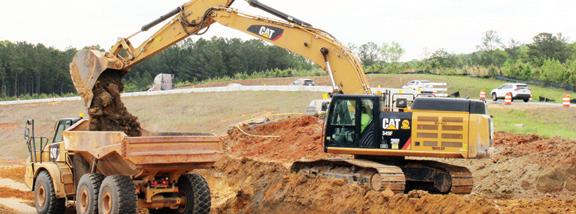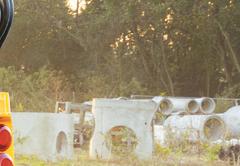










By Irwin Rapoport
As part of Georgia Institute of Technology’s multi-million-dollar upgrade of its athletic infrastructure through its “Full Steam Ahead” fundraising initiative, DPR Construction is building the Thomas A. Fanning Student-Athlete Performance Center (Fanning Center) at the Bobby Dodd Stadium at Hyundai Field in Atlanta.
Work on the stadium’s northeast corner began in March 2024 and should be finished in the spring of 2026, with the building open to the public shortly afterward.
The Fanning Center is replacing the concrete Brutalist–style former Edge/Rice Center with a building that is technologically advanced yet sensitive to the surrounding buildings. The new center will include a significant area of glass, which extends from the exterior of the stadium to a section of seating overlooking the football field’s end zone.
S/L/A/M Collaborative (SLAM) designed the 100,000-sq.-ft. building to improve the performance of Georgia Tech athletes. The Fanning Center will include spaces for sports medicine, athlete strength and conditioning, academic support, nutrition support and a sports science lab that employs pro-model motion tracking to ana-
lyze athlete performance data.
There is also space dedicated to Georgia Tech football — meeting spaces and coaches’ offices.
The building is named in honor of Georgia Tech alumnus Thomas A. Fanning, who holds three degrees from the institute and served as its president and CEO of the Southern Co. from 2010-2023.
SLAM completed the design in 2024.
DPR Construction is the contractor.
“The building is on a very tight site that abuts two existing operational buildings,” said Marc Clear, a SLAM principal.
“Connecting to these buildings to improve circulation on game days and every day was paramount. The building is designed to seamlessly connect to both buildings at roughly 15 different locations. This design dictated an unusual footprint that is structurally challenging as well.”
“The building has a high-performing envelope in order to operate efficiently and reduce energy usage for heating and cooling the building,” he added.
“Connections to these buildings had to be closely coordinated to maintain the performance of the envelope as well as water tightness.”





The largest section of a widening project along Georgia Highway 20 north of the Atlanta metro area will soon be getting under way, the Georgia Department of Transportation (GDOT) announced.
The state agency awarded Marietta, Ga.’s C.W. Matthews Contracting Co. Inc. a $104 million contract to widen the roadway from Ga. 369 in Cherokee County to Post Road in Forsyth County. It is cur-
rently the largest active contract for road projects in northwest Georgia, GDOT noted in a news release.
This portion of the east-west Ga. 20 project runs approximately 6 mi. and will undergo an expansion to three lanes in each direction. Two phases in Cherokee County that stretch from Interstate 575 to Union Hill Road are nearly complete, while the Forsyth County phase from Post Road to North Corners Parkway is under construction with
a current completion date set for the summer of 2028.
The new construction will include the installation of reduced conflict U-turns (RCUTs) at various intersections and raised medians along the highway. That work is expected to get under way in the coming months and is slated to be finished in November 2028, according to the transportation department.


















































































Your choice of a sealed or pressurized cab is equipped with system, adjustable wrist rests and a suspension seat to help comfortably all day long. Controls are easy to use, and the i monitor provides customizable machine operator preferenc information.
Maneuvering on the jobsite is even easier with the Cat Stick traditional travel controls with levers and pedal to joystick c button.
an improved air conditioning p keep you working ntuitive Next Generation es and easy to read machine
Increased lifting, swinging and travel and multi-functional pe k Steer option. Switch from controls with a push of a erformance help you get the
are just a few of the safety feature
Maintenance is quick and easy on access at ground level with group
with a variable displacement pum es built into the
the Cat 306 CR. Routine check poi ped service points and robust servic &
mp, the Cat 306 CR was designed to ints are easy to ce panels. reduce operating
blade, angle blade or Extra Tool C
Contact our dealership today t excavator in the market. arrier (XTC). to learn more about the newest 6-t
The Fanning Center has a projected lifespan of 50-plus years.
One of the materials being used is cross-laminated timber (CLT), which the APA — The Engineered Wood Association describes as a “large-scale, prefabricated, solid engineered wood panel.” CLT is used for two areas of the Fanning Center roof.
“CLT is relatively new and gaining popularity,” Clear said. “Benefits include a structural system that is beautiful when left exposed, bringing the warmth of wood to the interior and exterior of the building without requiring an additional applied finish material. Wood structure is also very environmentally friendly as sustainably harvested wood is used that sequesters carbon from the atmosphere, reducing greenhouse gases while requiring significantly less energy to produce and fabricate than traditional steel and concrete building materials.”
He added that while the building will not pursue LEED certification, the firm applied the LEED Gold level as a design guide.
Those features include stormwater capture for irrigation; a high-performing envelope allowing HVAC systems to operate based on ventilation requirements rather than heating and cooling, resulting in reduced energy use; and concrete carbon reduction measures such as the reclamation and reuse of demolished building steel, cutting carbon dioxide emissions by more than 25,000 kilograms.
Steel from the portion of Bobby Dodd Stadium’s upper deck that was demolished to make room for the Fanning Center was repurposed into the new structure.
That stadium was built in 1913. The construction of the Fanning Center is not interfering with its operations.
A benchmark was attained on March 7 when DPR Construction topped out the Fanning Center.
So far, DPR has completed the following: demolition, site utilities, foundations, steel erection and decking. The remain-
ing elements are CLT/roofing, exterior finishes, interior finishes and hardscape/landscapes.
The construction process is trying to minimize the disruption of campus activities.
“One of the biggest construction challenges is not disturbing the day-to-day activities of the Georgia Tech Athletics Department,” said Heather Taylor, DPR’s project manager. “DPR Construction works closely with Georgia Tech Athletics staff to ensure all impacts are communicated far in advance so that the teams’ schedules are kept as consistent as possible. The work on site is running smoothly and on schedule.”
The demolition of the existing structure required careful planning.
“Our team took a strategic, phased approach to the demolition,” Taylor said. “We tackled the Edge Building first, before moving on to the northern portion of the stadium. The last phase was the demolition of the Rice Building.”
The whole demolition process took approximately eight months.
Approximately 40 tons of the steel removed from the stadium was repurposed into the Fanning Center structure.
The demolition had DPR crews use a Liebherr MK 1405.1E crane for the stadium dismantling and, for the building demolition, four Link-Belt 300 X4 crawler excavators, a Kobelco SK210LC-11 excavator, a Kobelco SK350LC-10 excavator and other pieces of iron.
With demolition complete, work on the Fanning Center began.
“For the construction of the exterior, there were multiple phases for each side of the building, and each varied depending on the trade,” Taylor said. “For the interior construction, each floor was broken up into two phases.”
This work involved a Terex SK 415-20 tower crane and MEC Micro 19 scissor lift.
With the Fanning Center topped out, the next steps are the placement of the exterior skin, interior, MEPs, framing, roof-
ing and CLT.
“For exterior skin, we are working from the south side to the east, and then north,” Taylor said. “We will finish the project on the west side. For interior MEPs, we started on the first floor and tackled each floor in two separate phases. The big push for this project is to be done with the south exterior before the 2025 football season and hitting the dry in-date is critical to our schedule.”
Taylor’s DPR management team is Greg Smith, Brad Adams, Zach Brooklere, Josh Matthews, Sarah Rohlsen and Yasir Sadiq.
“Our team works together well,” Taylor said. “We balance each other out and step in to help each other when needed. This supportive environment that we foster is the key to our successful projects.”
Peak days have 80 DPR Construction and subcontractor employees on site. The subcontractors include Green Circle Demolition, Alan Densmore, Keller, Maxim, Wheeler, Faith, McKenney’s, Fitzgerald, PASCO, Chambless, Jollay Masonry, Steel LLC and Place Services.
New materials being brought in include 927 tons of steel and 2,500 cu. yds. of concrete.
DPR’s equipment maintenance program is critical to minimizing equipment downtimes.
“We have not run into many wear and tear issues since regular maintenance is always kept up,” Taylor said. “If a repair is needed, we can usually have a mechanic/tech onsite within a day, if not the same day. Routine maintenance is called in and performed on-site on a regular basis.”
DPR’s main equipment partner is OES Equipment.
“OES Equipment is a sister company of DPR Construction,” Taylor said. “The connection allows DPR Construction to handle each project smoothly and ensure that equipment being leveraged is reliable to prevent any issues.” CEG
(All photos courtesy of Danny Karnik Photography.)
RCUTs are proven to enhance safety by directing side-street traffic to make right turns followed by U-turns at designated locations. This configuration reduces the likelihood of angle and head-on collisions, which are typically the most severe.
“This next phase represents about a quarter of the entire project,” said GDOT District 6 Engineer Grant Waldrop. “We appreciate the public’s patience during the construction and we look forward to the smoother traffic flow once it’s all complete.”
Further to the east in Jackson County, GDOT has officially begun construction on another safety-focused project at the intersection of U.S. 441 and Ga. 326/Old Carnesville Road in the town of Commerce.
It, too, includes building an RCUT along the roadway to improve traffic flow and
reduce crash severity.
Construction began March 4, 2025, and is slated to be finished by the end of July 2025, weather permitting.
The junction of U.S. 441 and Old Carnesville Road has been identified as a high-risk location with a history of severe vehicle crashes. By implementing the RCUT design, GDOT aims to significantly reduce the number of conflict points and eliminate dangerous left turns and cross-traffic movements.
“The safety of Georgia’s road users is always our top priority,” GDOT said in its news release about the construction. “This project is a proactive measure to make this intersection safer and more efficient for everyone traveling through the area.
In the last week of March 2025, GDOT also provided updates on other transportation
infrastructure projects in two counties within the agency’s District 6, which encompasses a total of 17 counties in the northwest corner of the state.
In Bartow County, reconstruction is ongoing at the site of the intersection of U.S. 41’s bridges over Ga. 293 just south of the community of Emerson.
GDOT said that crews are installing a retaining wall on the northbound roadway side in preparation to remove the northbound highway bridge. The agency expects the work to be completed in December 2025.
In addition, south of the city of Cartersville, the widening of Old Alabama Road from Ga. 113 east to Paga Mine Road is continuing, with new work including construction of all three bridges along the highway and the installation of storm drains. GDOT is projecting that contract will be concluded in June 2025.
Just north of Barrow County is Gordon
County, where three more GDOT projects are either under way or scheduled to begin in the near future, including:
• The reconstruction of two Ga. Highway 136 highway bridges over the Coosawattee River, where crews are currently building the new eastbound structure. Once that is done, they will shift their attention to the demolition of the westbound bridge and shift traffic in both directions to the eastbound bridge. The entire project is slated to be done sometime in December 2025.
• Construction of another RCUT will begin soon, according to GDOT, on Ga. 53 at Brownlee Road/Plainville Road, with the work tentatively planned to end in March 2026.
• Intersection improvements also are being made at the junction of Ga. 156/Red Bud Road and U.S. 41/Wall Street near downtown Calhoun. Utility relocations are already under way in order to have the effort completed by April 2026.







































